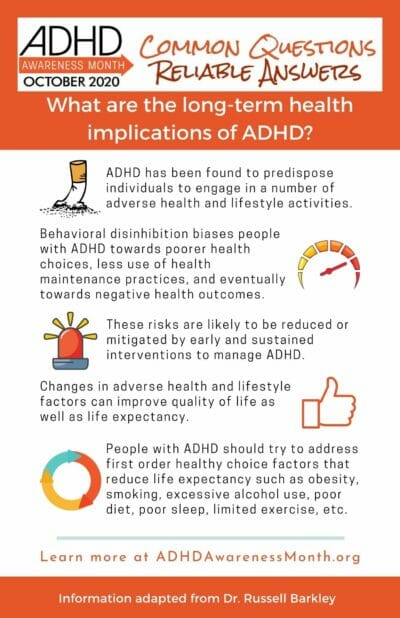More than 50 years ago, studies on ADHD (then called hyperactive child syndrome or hyperkinesis) began to show markedly elevated risks for accidental injuries of virtually all forms among children and youth with the disorder, including burns, poisonings, dental trauma, lacerations, broken bones, as well as closed head trauma, among others. Moreover, ADHD is linked to increased adverse consequences in nearly every major domain of life activity studied to date whether in children, teens, or adults. Many of those domains have a direct or indirect impact on health, such as risk for increased reactive aggression, crime and drug use, poor diet, sedentary activities, personal stress, and intimate partner violence. Adverse driving outcomes, including more vehicular crashes, are also associated with ADHD as is an increased risk for suicidal ideation, attempts, and completions. Among the more recently studied domains have been the direct adverse health consequences linked to growing up with ADHD. These include an increased risk of seizures, obesity, eating pathology, tobacco, alcohol, and marijuana use, dental caries, and plaque (besides trauma), sleeping problems, migraines, and risk for future coronary heart disease. The disorder is also associated with a decreased involvement in preventive health, nutrition, and dental hygiene activities.
All of these findings would predispose to an increased risk for greater morbidity (injury and disease) and likely earlier mortality. Hence, one should not be surprised that studies over the last 20 years showed that children with ADHD are nearly twice as likely to die by age 10 than are typical children, primarily due to accidental injury. This risk doubles again by adulthood where several studies showed that adults with ADHD are 4-5 times more likely to die by mid-life than are typical adults. This early mortality often results primarily from accidental injury but also by suicide and homicide. Many of the health conditions cited above are well-known correlates of reduced life expectancy and are used in algorithms that predict life expectancy as occurs in public health research and in the life insurance industry.
Does ADHD reduce total estimated life expectancy (ELE) if left untreated?
One recent study by Dr. Mariellen Fischer and myself was the first to focus on that issue. It found a striking reduction in ELE linked to the disorder by young adulthood. It reported that cases having hyperactive child syndrome, or ADHD-Combined Presentation, in childhood manifested a 9.6 year reduction in healthy ELE in remaining years, a 1.2 year period of greater unhealthy life expectancy in remaining years, and an overall 8.4 year reduction in total life expectancy than did control children by young adulthood. Moreover, the persistence of ADHD to adult follow-up was associated with an even worse impact on these ELE measures, with a 12.7-year reduction in healthy life expectancy and an 11.1-year reduction in total ELE than was seen in control cases. Persistent cases had a 5.3-year reduction in healthy life expectancy and a 4.6-year reduction in total ELE than nonpersistent ADHD-C cases. And both persistent and nonpersistent ADHD cases had significantly lower ELEs by adulthood than did control cases.
The magnitude of such reductions in life expectancy is both stunning and sobering when one realizes that such reductions are far greater than those associated with smoking, obesity, alcohol use, high cholesterol, and high blood pressure either individually or combined! Why? Because ADHD has been found to predispose individuals to engage in a number of such adverse health and lifestyle activities.
For instance, we noted that the disorder reduced ELE in our study through its association with eight of the 14 variables entered in the ELE calculations. These included the demographic factors of reduced education, lack of high school graduation, and lower annual income in the ADHD-C groups but also in the health and lifestyle factors of greater alcohol consumption, poorer overall health, reduced sleep, increased likelihood of smoking and of smoking more than 20+ cigarettes per day, and possibly greater adverse driving consequences resulting in license suspensions and revocations. It is chiefly the background trait of behavioral disinhibition that biases those with ADHD toward poorer health choices, less use of health maintenance practices, and so to eventual adverse health outcomes.
Recently, a large-scale study that scanned the human genome of thousands of cases involving ADHD as well as typical people showed that there is a shared genetic risk between ADHD and certain health related outcomes. Those included lower educational attainment, obesity, diabetes, smoking, sleep, level of high-density lipid cholesterol, earlier age of parenthood, risk for rheumatoid arthritis, earlier menopause, etc. All of this further supports the conclusions that ADHD and its linkage to poor inhibition and low conscientiousness are important genetic background or second order factors that link to the first order factors involving health and lifestyle choices that are shortening the life expectancy in those with ADHD.
These findings should give impetus to efforts to try to educate those with ADHD and their families to such risks as well as to reduce those first order healthy choice factors that are predisposing to reduced life expectancy, such as obesity, smoking, excess alcohol use, poor diet, poor sleep, limited exercise, etc. After all, estimated life expectancy is malleable – change the adverse health and lifestyle factors affecting it and one can improve quality of life as well as life expectancy. Adding ADHD medications and evidence based psychosocial treatments to address the background traits predisposing those with ADHD to engage in these first order adverse health activities is also likely to be necessary and effective.
Recent large-scale studies find that ADHD medications reduce many of the health and lifestyle risks noted above including those for accidental injuries, mortality, driving risks, antisocial activities, and drug use, among others. These findings also argue for making primary care physicians more aware of the linkage between ADHD and reduced life expectancy as they are the ones most likely to be trying to improve the adverse health and lifestyle activities of individuals. Yet they are not screening for the significant role that ADHD may be playing in the failures of their patients to do so.
About the Author

Dr. Barkley is a Clinical professor of Psychiatry at the Virginia Commonwealth University Medical Center in Richmond, Virginia, USA. He has published more
than 27 books, rating scales, and clinical manuals and more than 300 scientific papers and book chapters on ADHD, and has presented more than 800 invited lectures in more than 30 countries. His latest books are Taking Charge of ADHD:
The Complete, Authoritative Guide for Parents (4th ed., June 2020, Guilford press) and The 12 Principles for Raising and Child with ADHD (October 2020, Guilford
Press). His website is https://www.RussellBarkley.org.
Supporting Scientific Articles
- Barbaresi, W. J., Colligan, R. C., Weaver, A. L., Voigt, R. G., Killian, J. M., Katusic, S. K. (2013). Mortality, ADHD, and psychosocial adversity in adults with childhood ADHD: A prospective study. Pediatrics, 131, 637-644.
- Barkley, R. A. (2015c). Health problems and related impairments in children and adults with ADHD. In R. A. Barkley (ed.) Attention deficit hyperactivity disorder: A handbook for diagnosis and treatment (4th Ed)(pp. 267-313). New York, NY: Guilford Press.
- Barkley, R. A. & Cox, D. J. (2007). A review of driving risks and impairments associated with Attention-Deficit/Hyperactivity Disorder and the effects of stimulant medication on driving performance. Journal of Safety Research, 38, 113-128.
- Barkley, R. A. & Fischer, M. (2019). Hyperactive child syndrome and estimated life expectancy at young adult follow-up: The role of ADHD persistence and other potential predictors. Journal of Attention Disorders, 23, 907-923.
- Barkley, R. A., Murphy, K. R., & Fischer, M. (2008). ADHD in adults: What the science says. New York: Guilford Press.
- Dalsgaard, S., Ostergaard, S. D., Leckman, J. F., Mortensen, P. B., & Pedersen, M. G. (2015). Mortality in children, adolescents and adults with attention deficit hyperactivity disorder: a nationwide cohort study. Lancet, 385, 2190-2196.
- Demontis, D. et al. (2018). Discovery of the first genome wide association significant risk loci for attention-deficit/hyperactivity disorder. Nature Genetics. Epub ahead of print. doi.org/10.1038/s41588-018-0269-7
- Jokela, M., Ferrie, J. E., & Kivimaki, M. (2008). Childhood problem behaviors and death by midlife: The British National Child Development Study. Journal of the American Academy of Child and Adolescent Psychiatry, 48, 19-24.
- London, A. S., & Landes, S. D. (2016). Attention deficit hyperactivity disorder and adult mortality. Preventive Medicine, 90, 8-10.
- Mohr-Jensen, C., & Steinhausen, H. C. (2016). A meta-analysis and systematic review of the risks associated with childhood attention-deficit hyperactivity disorder on long-term outcome of arrests, convictions, and incarcerations. Clinical Psychology Review, 48, 32-42.
- Nigg, J. T. (2013). Attention-deficit/hyperactivity disorder and adverse health outcomes. Clinical Psychology Review, 33, 215-228.
- Virtanen, M., Lallukka, T., Alexanderson, K., Ervasti, J., Josefsson, P., Kivimaki, M., & Mittendorfer-Rutz, E. (2018). Work disability and mortality in early onset neuropsychiatric and behavioral disorders in Sweden. European Journal of Public Health, 28, Supplement 4, p. 32.

